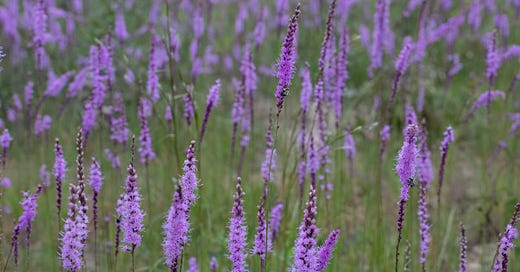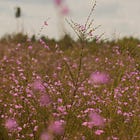Once again, I was on my way to my favorite place in Georgia, the Fall Line sandhills. Located about 100 miles southwest of Atlanta, two tracts of Wildlife Management Area lie in Taylor County. I was headed to the West tract, south of Talbotton, for a field trip with the Georgia Botanical Society, and in the evening, as I nearly always do after field trips, I detoured to the East tract, near Butler, for a quiet walk on my own.
This time as I headed south, I tried to keep track of the roadsides to determine where exactly the red clay changes to almost-white sand. Along US 41, bright green grass waved in the wind from soil the color of a robin’s breast and belly — red-orange, more orange than red, and just as the robin’s feathers, the soil shone and glowed in the sunlight like a bright orange light. Further south, approaching Talbotton, US-41 took me through soft hills of deep copper; they lay in shadow, not yet warmed by that morning’s sun. As I turned left onto Highway 90, moving closer to the Fall Line Freeway (SR 540), the red roadside soon turned to a cover of green grass so dense I could not see the soil beneath. Once again, it seemed sudden to see only sand at the intersection of SR 90 and SR 540, both north and south of the Fall Line Freeway.
I continued on familiar roads, briefly east on SR 540, turning right and south on SR 96, left onto Fox Run Road, past houses and fields where cows graze, sometimes accompanied by cattle egrets. Past the cows, the paved road turns to sand and intersects with Kelley Foster Road. I turned right at the entrance to Sandhills West WMA.
Nothing could have prepared me for the sight, the splendor, of the Liatris tenuifolia superbloom. This is my fourth autumn visiting the sandhills during the superbloom; every year is different. This year it was a haze, a fog, a sea of purple, purple wands waving in the wind with a few spots of white from a few odd white-flowered members of the species.
This year’s prescribed fire took place around late April to early May, which turned out to be favorable to this particular species of liatris. Liatris tenuifolia’s common name, short-leaved liatris, is an understated description of the plant’s understated leaves. Visible only when one is close and really examining the plant, they are like green stubble, short and thread-thin, and they lie close to the stem so that from a distance, they are barely visible at all. From a distance, the plant is a waving stem bedecked in purple splendor.
In A Field Guide to the Wildflowers of the Sandhills Region, botanist Bruce A. Sorrie writes of the species:
Slender Blazing-star is a survivor extraordinaire, able to eke out an existence in the most barren of habitats in nutrient-poor, acidic sand. Yet it carries itself with a grace that defies its inhospitable environment.
A golden glow came into view below the purple splendor, the yellow composite flowers of several species that grew beneath the towering liatris. Much of this was Sandhills Golden-aster, Pityopsis pinifolia, a rare plant so common in this region that one of its common names is Taylor County Golden-aster. Later in the day, we visited a ridge where, between the longleaf pines, this rare species predominated. A sea of yellow stretched into the distance, with only an occasional wand of Liatris tenuifolia rising above its surface.
In other sections of the sandhills, where prescribed burns had taken place during different months, other flowers made up the superbloom. Gone were the fluttering pink petals of Warea cuneifolia, a summer wildflower described and pictured in my last post about the Sandhills; Dicerandra linearifolia took its place, a member of the mint family with a multitude of delicate pink flowers on slender stems with fragrant, needle-like leaves.
At both the West and East tracts, arthropods were as abundant, varied, colorful, and delightful as the flowers. Shining black autumn tiger beetles darted across the sand at our feet. With huge heads relative to the rest of their downy, copper-red bodies, Florida harvester ants bustled back and forth from the entrance of their charcoal-ringed nests. Silvery-white and golden brown Florida garden spiders, more abundant when I visited in August, still stretched their webs between the branches of bluejack oaks and other short trees. Yellow crab spiders hid, camouflaged, in the centers of golden-asters, waiting to capture pollinator prey. Both common Eastern and endangered Southern plains bumblebees visited the liatris. Scoliid wasps, both blue-winged and feather-legged, foraged among the Dicerandra and Dalea. Bee flies (family Bombyllidae) flew over the sand, laying eggs on the ground and visiting flowers in between. With a pair of large dark eyes peeking out from small, round bodies covered in woolly golden fluff, these bee flies resemble winged teddy bears. Like actual bears, though, Bombyllidae are predators. The females lay their eggs on the ground, near the nests of other insects, such as bees, wasps, and grasshoppers; bee fly larvae hatch from these eggs, invade the nests, and as parasitoids, eventually devour the larvae of their prey species.
In previous years, migrating monarch butterflies fluttered among the sandhills at the turning of September to October; this was the first year that I saw no monarchs at that place and time. Orange butterflies were not absent; gulf fritillaries instead soared throughout the superbloom, stopping to sip nectar from the short-leafed liatris.
I stayed after the field trip ended to take photographs of the field of liatris; clouds had rolled over the sunny sky, diffusing the light that had been a bit harsh that morning. Around 6:00pm, I headed north towards home, but a few moments in the car had, as always, given me a boost of energy. You never regret a trip to Sandhills East, I told myself. Despite the evening hour and hundred miles of driving ahead of me, I turned right on the Fall Line Freeway, heading east towards Butler.
Train tracks lie between the East tract and the highway that forms its southern border; a solar farm stretches along the WMA’s eastern edge. Despite these signs of industry, Sandhills East is quiet and wild.
That September evening, I found it a place of muted color and sound. Its sand is bone-white, paler than the beige sand of Sandhills West; its superbloom was less ostentatious than the West tract’s riot of purple and pink. As I began walking along the soft sand trail, where I expected to see flowers, I saw a field of tall, waving grass on my left; on the right, I noticed that for the first time, I could not see the border of cucumberleaf sunflowers that usually separates the WMA from the solar farm. I kept walking; yellow began to dot the green expanse, like stars appearing in the sky — the flowers of goldenrod and golden-asters. Pink-stemmed, with fluffy white flowers on stalks that bent and curved like snakes slithering over the sand, Froehlichia floridana (Plains snakecotton) stood above the grass. As I continued, more and more flowers filled the space — a patch of spotted beebalm (Monarda punctata) mostly past bloom, fading yet still a tower of yellow and pink; a group of purple-trumpet-flowered Agalinis with buckeye caterpillars feasting on their thread-thin stems; more golden-asters and scratch-daisies blending into a yellow glow on the ground. Scant starburst sedge (Cyperus plukenetii) stood among them, a brown stalk splitting at the top into a firework of thin brown branches, each supporting a cluster of seeds. I saw few, if any Liatris tenuifolia, but as I continued down the sandy trail, a different liatris soon predominated the landscape. Here I found a superbloom of Liatris elegans, elegant blazingstar, wide stalks of densely packed florets, each wreathed by long, pale, pointed bracts; the overall effect is of towers of white lace.
Just before I turned back down the trail, my vision caught a small, pale flutter among the flowers. It was a dainty sulphur butterfly (Nathalis iole), the first I had ever seen. A second soon joined me as I came within view of my car. Dusted with gray, their wings were pale as the sand, with a patch of yellow bright as the sunlit golden-asters of the superbloom, bright as the sun that was dropping below the sandhills.
Read the first in the Sandhills series here:
and a flash essay about my first visit to the Ohoopee Dunes here:
and that time I fell in the Black Creek Bog during my first fall superbloom Botanical Society trip:
A flash essay I wrote about the Sandhills in fall was published in Deep Wild 2024. Excerpt here.



















Reading this is pure heaven for me.
So much to love about this one ... the vivid imagery and stunning photos. I hope to see something as spectacular as a superbloom someday. And a Dainty sulphur butterfly.